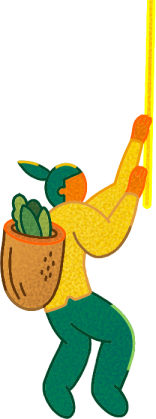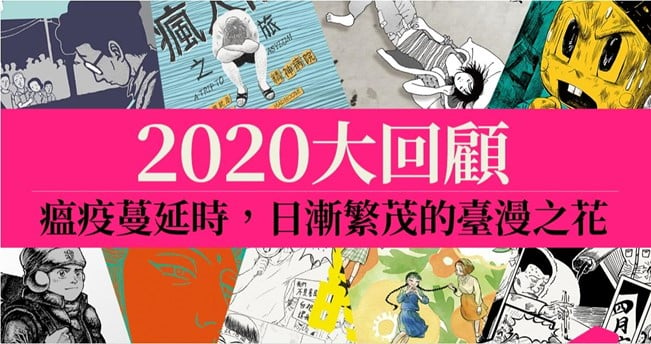About the Author
A student of history. Assistant Professor at Department of History, National Chi Nan University. Theoretically, the author should be making a living in academia, but spends most of his time doing things unrelated to his occupation, as well as regretting it afterwards.
We Create Comics during the Age of the Great Pandemic
To look back at Taiwanese comics in 2020, we must mention this cursed year of the great pandemic.
Like the common scene in sci-fi comics, the outbreak of the pandemic early in the year seemed to open a singular point that took us through spacetime into a parallel universe. All the daily norms we grew accustomed to suddenly became unattainable dreams. Going overseas and coming back home were no longer convenient, and every day, we carefully washed our hands and wore masks, living the life of pandemic prevention. Through the cooperation of the government and citizens, Taiwan was relatively lucky compared to the apocalyptic scenes like “Resident Evil” happening around the world, but we were nonetheless affected by the pandemic.
The comics industry was no exception. Most directly, many cosplay events were forced to be postponed or cancelled, severely impacting many creative professionals who looked forward to setting up booths for more income or exposure at these events. A compromise was perhaps converting to an online book fair, like the “Man Man Manga Festival” organized by Mangasick. However, with the domestic outbreak of the pandemic effectively controlled, related activities resumed, and major events included the two C.W.T. (Comic World Taiwan) events in summer and winter, the First “Publishing Creative Fair” in October that focused on original comics and illustrations, and “Taipei Art Book Fair” in November; there were also many mid-scale events, such as new book releases, keynotes, and seminars, which were participated by many Taiwanese comic creators, as well as those comics lovers who needed some fresh air after being grounded for too long, and it was their version of “revenge travel.”
The more concerning thing was the long-term impacts resulting from the overall decline of the economy. Once the pandemic affected the economy, the cultural industry would be the first to be sacrificed by people as they cut down on expenses; Taiwanese comics, on the fringes of the cultural industry, would obviously take a more significant blow. In February, Ministry of Culture timely launched the Relief and Revitalization Measures for the Cultural and Arts Sectors Impacted by COVID-19, which included “relief assistance for culture and the arts, loans and interest subsidies, streamlined administrative regulations, and revitalization measures,” allocating billions of dollars with no holding back. Although the measures provided the cultural and arts sectors some breathing room, this kind of support would definitely falter if the pandemic lingered on, or experienced resurgence. Moreover, whether this kind of massive provisional expenses would squeeze out some normal subsidies, especially Taiwanese comics that still very much relied on government support at the moment, required continued observation; nonetheless, during the pandemic, every step must be taken with caution in order to care for and nurture the seedlings of Taiwanese comics that had just sprung up.
The Twisted Fate of National Comic Museum
When talking about the public sector, we must also mention the twisted fate of the National Comic Museum. Originally planned to be located in Taichung’s Shuinan Economic and Trade Park, it was announced in May that the original plan had fallen through, as the proposal faced backlashes from all sectors, and the planned hardware requirements could not be met. Fortunately, shortly after in October, it was announced that a new site was selected for the museum to remain in Taichung; Taichung City’s “Empire Sugar Factory Taichung Office” and “Taiwan Railway Warehouses on Xinmin Street“ were chosen as the new locations of the museum, and “National Comic Museum Preparatory Team” was established at National Museum of Taiwan History, simultaneously jumpstarting the preparation of software and hardware.
Taiwan has always relied on the private sector to take the initiative for the collection, exhibition, or research of Taiwanese comics. In addition to more systematically promoting related affairs through the power of the government, the crucial role of the National Comic Museum is to outline people’s imagination for Taiwanese comics through its establishment and planning, ensuring the connection between Taiwanese comics and readers and setting the fundamental tone for Taiwanese comics through its solid archive. This is why the museum that focuses on the past is so important to the comics industry that focuses on the present.
Since the announcement of the establishment of the National Comic Museum, it has been a bumpy road full of ups and downs, and it is inevitable that the many people involved get frustrated and discouraged. However, archiving and preserving comics and related documents through the power of the country, and then developing professional displays and academic studies, are a key step of utmost importance to the past, present, and future of Taiwanese comics. Only by constructing a fortress like this and attracting more people to understand, imagine, and discourse on Taiwanese comics within it can Taiwanese comics enjoy stability and longevity in the future.
Diverse Publication of Taiwanese Comics: Veterans Returned, History Remained Relevant, and Interdisciplinary Cooperation
2020 remained a year in which the publication of Taiwanese comics thrived. Not only did the quantity increase compared to 2019, the content was also diverse and exciting. Among the many publications, some phenomena are worth mentioning: First, the return of veterans of Taiwanese comics of the 1990s; perhaps indirectly influenced by Cheng Uen’s passing away and the memorial events that followed, many masters of Taiwanese comics in the previous century announced their return.
For example, Richard Mai, who put aside his animation dream and picked up the paintbrush again, displayed once again the unique graphic vocabulary of “Uncle Mai” through new work Iron Boy: Pirate Town 1. The republication of Ren Zheng-hua’s out-of-print works, Drawn to Life and Human Flesh Buns, was a great comfort for the many fans, allowing them to revisit her sharp observation of human emotions and relationship. At the end of the year, there was also Head Over Heels: Petit Bourgeois Lovers by Alice Chang. As the pioneer of urban love stories in Taiwanese comics, Alice’s style remained slick and clean, yet she returned with a more profound realization of love. The return or comeback of comics veterans showed that Taiwanese comics had gradually connected the countless dots into an axis of lineage, and the dialogues between different generations would definitely ignite greater sparks.
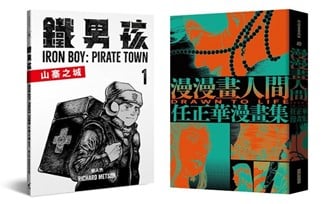
Ren Zheng-Hua / Drawn to Life / Courtesy: Locus Publishing Company
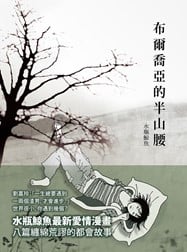
Second, through Creative Comic Collection’s (CCC) promotion over the years, Taiwanese comics continued to delve into the theme of history, which had become one of the diverse themes of Taiwanese comics. Kinono’s Dutchman in Formosa and Kiya Chang’s Formosa Oolong Tea had readers longing for more, and their much anticipated sequels Dutchman in Formosa II and Formosa Oolong Tea 4 were finally published, demonstrating Taiwanese historical comics’ potential of continuing the story.
With a focus on local politics and historical publications, Avanguard Books also published the White Terror-themed The Last of Article 2, Paragraph 1: The End of the 1991 Rebellion and 46:1949 The Beginning of White Terror. Son of Formosa published by Slowork Publishing perhaps best represents Taiwanese historical comics. Depicting the life of White Terror victim Tsai Kun-lin, this comic not only demonstrated Slowork’s maturity in the domain of documentary comics, but also displayed the expressive ability of pictures that surpassed written records.
Others included Rain Marshal by M2, Tomoe’s Memories of Koumeya by Qingshui, and Tamsui Guardian by Waste Woood, as well as the ongoing Sasaburo Yo in Paris by HOM based on the life of Taiwanese artist Yang San-lang. It looks like the robust scene of Taiwan’s historical comics will continue for quite some time.

Chang Wen-Chi, Money Chen / The Last of Article 2, Paragraph 1: The End of the 1991 Rebellion / Courtesy: Avanguard Books
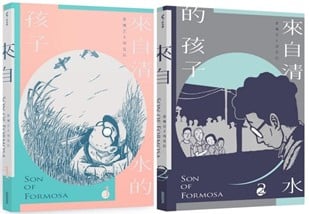
In addition to historical themes, various interdisciplinary collaborations also injected new creative energy into Taiwanese comics. Mayfly Island, similar to Spirits of the Forest in the previous year, acted as a lead up to or a spinoff of the animation, delivering an epic in the style of Miyazaki Hayao. Fish Wang’s Secret Whisper adopted a similar method, telling a coming-of-age tale of a robot through his unique imagination. Although the animations have yet to come out, it would be worthwhile enough to get a sneak peek through these comics. Monday Recover and Yang Shuang-tzu collaborated on Kitan Hana Monogatari (Tale of Kitan Blossom), combining comics with literature. Both authors were leading yuri (lesbian) creators in respective domains, and they not only preserved respective unique characteristics in the new work, but also created a certain rare poetic feeling. Also based on literature work, the adaptation of Wu Ming-yi’s The Magician on the Skywalk by Sean Chuang and Juan Kuang-min was a can’t miss masterpiece. It was more than just sparks ignited by different creative media; later on, with the premiere of the TV series, it further explained that to achieve cultural profitability, we probably did not really need some big IPs, but simply a good story.
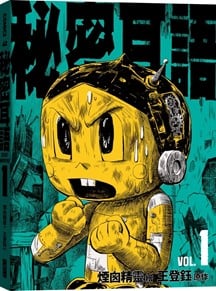

Challenging Existing Frameworks, Telling Own Stories: Restructuring of Golden Comic Awards and Transformation of CCC
Using own voices to tell own good stories was perhaps what had made Taiwanese comics attractive and charming in recent years.
We had someone like Chang Sheng, who is always disciplined. His new work YAN combined Peking opera with superhero, displaying a grand ambition, as well as his extensive experience on the sci-fi theme. Rimui published two works, The Funeral Concerto and Where Are You Going? – Farewell of Love, which featured swift storytelling, giving them great potential for direct adaptation. Among them, The Funeral Concerto won the Gold Prize at the Japan International Manga Award. SALLY’s Left Hand series was the same; focusing on the issue of schoolyard bullying, the series tells a story about the sorrows and bitterness of adolescence, which has become a constant theme in her publications or doujin works.
Moreover, Taiwan also has comics like Elainee’s OT Diary and PAM PAM LIU’s A Trip to Asylum that extensively preserve the “underground” colors and overlook the graphic conventions of the mainstream world. The authors use their own lines and strokes to fuse their own “styles” into the storytelling, regardless of documentary or fiction.

PAM PAM LIU / A Trip to Asylum / Courtesy: Slowork Publishing
In short, in the world of Taiwanese comics, there are all kinds of ways to tell a good story. We have storytellers like YinFu, who sticks to orthodox narratives of Japanese comics, simultaneously presenting MEOW Mystic Emissary of Wonder, the comic adaptation of a mobile game, and an original work, Waker; we also have Animo, whose The Short Elegy won the recognition of the 2020 Bologna Ragazzi Award Comics – Young Adult, which was a highly artistic work that challenged or shattered all conventions of comics. Regardless of what kind of graphic languages the authors chose, it did not hinder their chances of telling a good story, which offered readers more choices, and explored greater possibilities for comics.
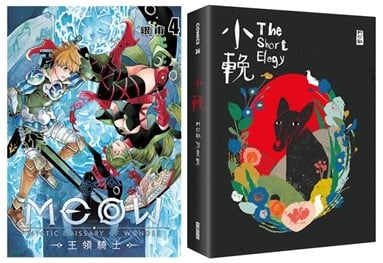
Animo / The Short Elegy / Courtesy: Locus Publishing Company
The Golden Comic Awards underwent restructuring this year to respond to the diverse looks of Taiwanese comics. It no longer recognized comics in the categories of comics for boys, girls, and young adults; instead, it broke the framework of categories, selecting six winners of the “Comic of the Year” award, and then selected one winner of the “GCA Grand Prize.” Through this transition, there were nonetheless different opinions along the way; however, it is undeniable that the traditional categorization is no longer applicable to the diversity of Taiwanese comics.
The transformation of the Golden Comic Awards was a declaration that Taiwanese comics should bravely challenge the limitations of categories. Supported by the government, creators should stride forward, embarking on their own “Ways of Manga.” Of course, the six winners of Comic of the Year could be put into different categories if the organizer really wanted to, but these works more or less had some factors or scales that transcended beyond own categories. The GCA Grand Prize-winning Time Swirl by NOBI Chang was the best example; rather than categorizing it as a specific type of comic, it would be better to describe it as a work similar to Lu Xun’s famed Old Tales Retold.
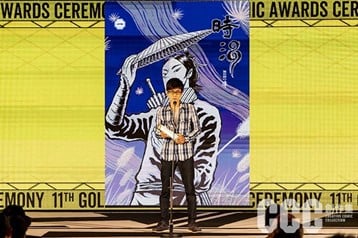
Since Taiwanese comics were always on the edge, they might as well take advantage of the position, and be brave to break existing frameworks and challenge the central conventions or formulae.
In addition to the Golden Comic Awards, CCC also transitioned from a printed monthly publication into a digital platform, which also symbolized the self-breakthrough of Taiwanese comics. As one of the most important driving forces of Taiwanese comics in recent years, CCC was transferred from Academia Sinica to Taiwan Creative Content Agency (TAICCA); it was not just a change of agency, but also a change of thinking and perspective. As a printed publication, CCC was backed by the research capacity of Academia Sinica, which allowed Taiwanese comics to make breakthroughs in terms of content; entering the digital age, the challenge is to make use of the characteristics of digital media to create for Taiwanese comics models of operation and reading on the existing foundation. Transplanting Taiwanese comics originally thriving in pots into digital soil, allowing it to blossom through the nurturing of a broader world; bidding farewell to paper was inevitably saddening, but it seemed to be a necessary step to take in order to break existing frameworks.
We Continued to Stride Forward beneath the Shadow of the Pandemic
With the pandemic lingering on, we must take each and every step with caution. Fortunately, the investments in Taiwanese comics over the past few years, whether by the government or the private sector, had gradually blossomed into fruition. We have outstanding creative talents from different generations, and the status of comics is gradually rising. Exhibitions, overseas copyrights, or even overseas awards, are no longer news, and have become the new norm of Taiwanese comics. Taiwanese comics have gradually developed own personalities and characteristics, and are no longer just emulating or following suit. Fighting on the margin, it is undoubtedly impractical to wonder how to make millions of dollars like others; what we should really be concerned about is how to tell a good story, and give those comics lovers in the world an opportunity to see it.
The wheels are turning for Taiwan’s comics to move forward. We should let go of the meaningless frameworks, and cautiously march ahead during the pandemic. One day, the world will listen to our stories.
Original text: https://www.creative-comic.tw/special_topics/147

